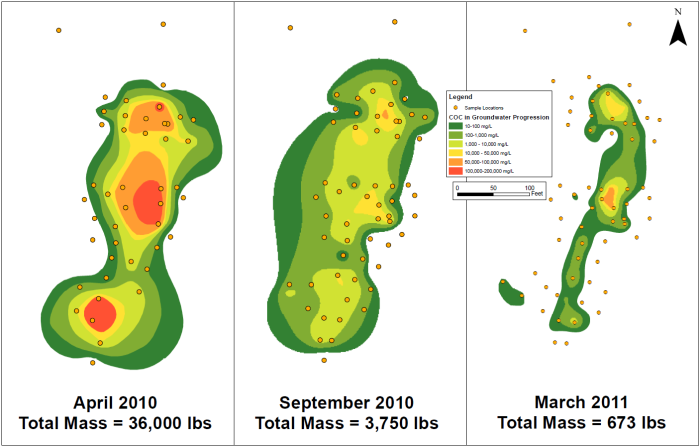Example 2
| Example 2: Plume Shrinkage Analysis |
|---|
|
Application: Plume shrinkage analysis
Application Summary: Plume concentrations were interpolated over different time steps during in-situ remediation to quantify trends in mass reduction. Software: Surfer, ArcGIS or other software capable of spatial interpolation and grid math or area/volume analysis. Methods: Any interpolation method, grid multiplication, or grid volume and area calculations. Data Requirements: See recommendations regarding data requirements for kriging. Reference: Ricker 2008 |
|
Approach: Plume shrinkage over time is an important remediation question identified in Section 2. Evaluating this question involves creating a series of geostatistical plume maps at distinct times to assess reductions in extent and/or intensity. Changes in plume area, average concentration, and mass over time can be quantified using grid or raster tools in software such as Surfer or ArcGIS. These metrics can then be statistically trended to evaluate remedial progress and inform optimization decisions. This process is similar to spatial moment analysis as performed in MAROS, but allows more flexibility as plume mass calculations are performed manually by the user using any interpolation method.
Results: Figure 54 is an example, hypothetical visualization showing reductions in plume size and total dissolved phase mass during in-situ remediation. These plume maps and mass calculations were performed in ArcGIS through the following steps: |
- Interpolate monitoring well concentrations and aquifer saturated thickness measurements using kriging or another method to create raster grids of continuous predictions.
- Convert these floating point rasters to integer rasters.
- Convert the integer rasters to polygons and join concentration and thickness properties together in the same feature class using a union command.
- Calculate the area of each grid cell using the calculate geometry function.
- Calculate the dissolved mass of each cell by multiplying the area by the saturated thickness by the concentration by the porosity (which could be an assumed uniform value or an interpolated grid like saturated thickness).
Ricker (2008) describes an alternative approach to calculating plume mass using Surfer. After creating an interpolated concentration grid in Surfer, a grid volume report can be generated to calculate the positive volume and planar area of the grid. The average plume concentration can be approximated as the concentration grid volume (in units of µg/L*m2) divided by the concentration grid planar area. The plume boundary concentration representing the outer extent of the planar area should be added to the calculated average concentration. To obtain mass, this average concentration can be multiplied by the plume area and assumed uniform values of saturated thickness and porosity.

Figure 54. Plume shrinkage and mass reduction over time.
Source: Courtesy of Ted Parks, AMEC Foster Wheeler.


